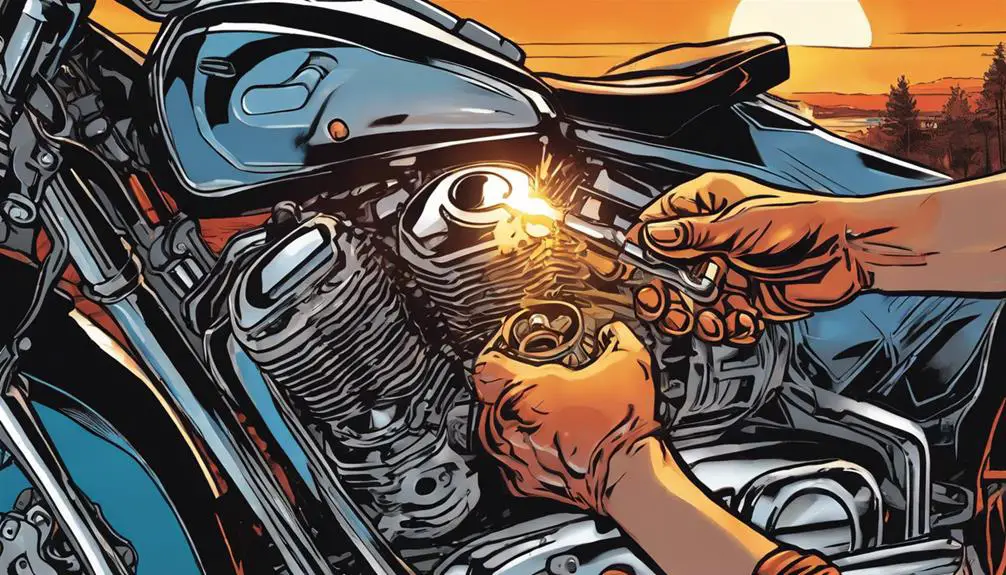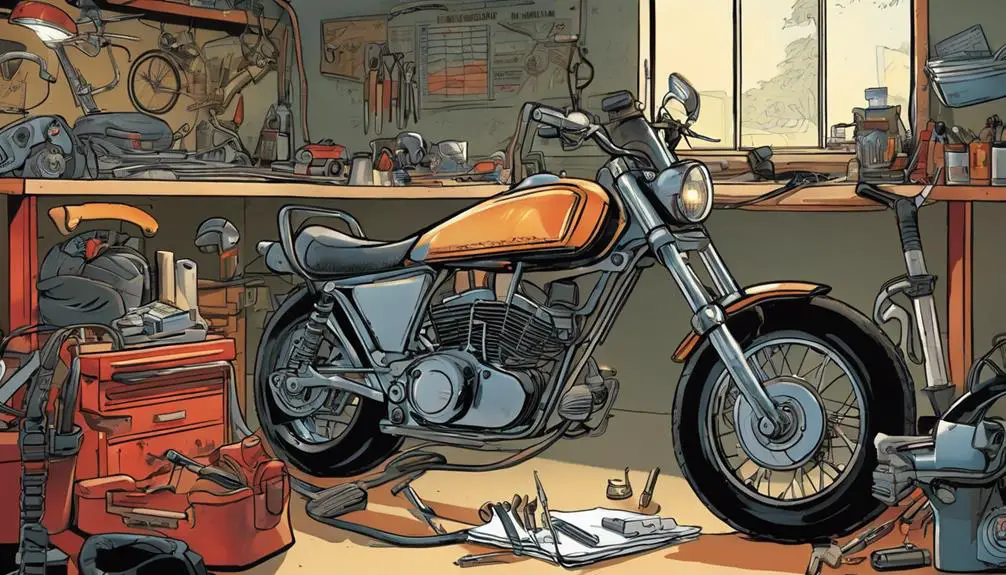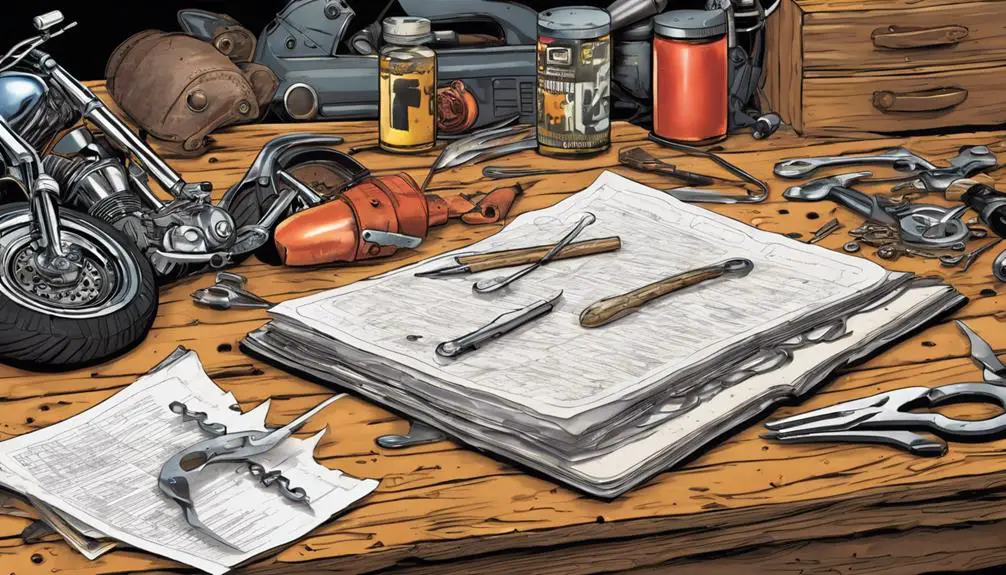To keep your motorcycle running smoothly, to enhance its resale value, and to guarantee a safe ride, you'll need to adopt a disciplined maintenance routine. While many riders overlook the importance of regular upkeep, neglect can greatly impact both performance and marketability. By focusing on key practices, you can not only enjoy your bike more but also make it more appealing to potential buyers. So, what are the essential steps you should take to protect your investment and maximize its worth? Let's explore some practical tips that can make a difference.
Quick Takeaways
- Perform regular oil changes every 3,000 to 5,000 miles to ensure engine longevity and performance.
- Maintain tire pressure and rotate tires regularly to enhance safety and extend tire life.
- Conduct monthly inspections of brakes, lights, and fluid levels for optimal functionality and safety.
- Establish a consistent cleaning routine to prevent buildup and maintain the motorcycle's appearance.
Regular Oil Changes

Changing your motorcycle's oil regularly keeps the engine running smoothly and extends its lifespan. When you take the time to change the oil, you're not just performing maintenance; you're embracing the freedom of a well-loved machine. Fresh oil reduces friction, preventing wear and tear that can lead to costly repairs down the road. Plus, it helps keep your engine clean, ensuring it performs at its best.
You should check the oil level frequently, especially before long rides. If it appears dark or gritty, that's a sign it's time for a change. Aim to replace the oil every 3,000 to 5,000 miles, depending on your bike and riding habits. Choosing the right type of oil is vital, too. Synthetic oils often provide superior protection and performance, enhancing your ride's efficiency.
When you take charge of your motorcycle's oil changes, you're not just maintaining a vehicle; you're cultivating a relationship with it. Each change empowers you, giving you the confidence to roam freely on the open road. Remember, a well-maintained bike isn't just a machine; it's your ticket to liberation and adventure.
Tire Maintenance Practices
Proper tire maintenance is essential for ensuring your motorcycle handles well and provides a safe ride, especially during long journeys. When you hit the open road, you want to feel the freedom of the ride. Keeping your tires in top shape is a big part of that. Here are three vital practices you can adopt:
- Check Tire Pressure: Make it a habit to check your tire pressure before each ride. Proper inflation maximizes grip and fuel efficiency, while under-inflated tires can lead to blowouts.
- Inspect Tread Depth: Regularly examine your tire tread for wear. Tread depth affects traction, especially on wet roads. Use the penny test—insert a penny into the tread; if you see Lincoln's head, it's time for new tires.
- Rotate Tires: Just like cars, your motorcycle tires wear differently. Rotating them can extend their life and maintain handling balance, giving you more freedom to ride longer.
Routine Inspection Schedule

Establishing a routine inspection schedule is essential for keeping your motorcycle in peak condition and guaranteeing your safety on the road. By taking control of your bike's maintenance, you not only enhance its performance but also embrace the freedom that comes from riding with confidence.
Start by checking your tire pressure and tread depth at least once a month. Proper tires are critical for stability and can make all the difference during a ride.
Next, inspect your brakes—look for wear on pads and check fluid levels. You want to make sure you can stop on a dime when adventure calls.
Don't forget to examine your lights and signals. Visibility is key, especially at night.
Regularly check your oil, coolant, and other fluids to keep your bike running smoothly.
Make it a habit to clean and inspect your chain, as a well-lubricated chain can enhance performance and longevity.
Cleaning and Detailing Tips
Keeping your motorcycle clean not only enhances its appearance but also protects essential components from dirt and grime. A well-maintained bike not only rides better but also holds its value longer.
Here are three tips to keep your ride looking sharp:
- Use the Right Products: Choose a gentle bike wash and avoid household cleaners that can strip wax or damage finishes. Invest in a quality microfiber cloth for drying—it's less abrasive and helps prevent scratches.
- Regularly Detail Hard-to-Reach Areas: Don't forget to clean under the seat, around the chain, and in the nooks of the frame. A soft brush can help you reach these areas and remove stubborn dirt without causing damage.
- Protect and Polish: After washing, apply a protective wax or sealant. This not only gives your bike a brilliant shine but also acts as a barrier against future grime and weathering.
Keeping Records for Resale

Maintaining detailed records of your motorcycle's maintenance and repairs can greatly boost its resale value and attract potential buyers. When you keep track of everything from oil changes to tire replacements, you create a narrative of care that buyers appreciate. They want to feel secure in their purchase, and your records provide that reassurance.
Start by organizing your documents in a binder or a digital format. Include receipts, service records, and notes on what you've done over the years. Don't forget to log when you performed maintenance tasks or significant repairs. This transparency builds trust and shows that you're a responsible owner.
If you've made any modifications, document those too. Buyers may be interested in the upgrades you've made, so include installation dates and costs. Photographs of your motorcycle during various maintenance stages can also add value to your records.
Lastly, keep your records easily accessible. When potential buyers come knocking, you'll be ready to showcase your motorcycle's history. This proactive approach not only enhances your bike's appeal but also empowers you in the selling process, making it a win-win for your freedom on the open road.
Common Questions
How Often Should I Replace My Motorcycle's Air Filter?
You should replace your motorcycle's air filter every 5,000 to 15,000 miles, depending on your riding conditions.
If you often ride in dusty or dirty environments, check it more frequently.
A clean air filter boosts performance and fuel efficiency, ensuring you ride smoothly.
Don't forget to inspect it regularly; a clogged filter can hinder your bike's power.
Keep that freedom alive by maintaining your ride's health!
What Are the Signs of a Failing Battery?
When it comes to a failing battery, you might feel like you're driving down a winding road without a map.
If your motorcycle struggles to start, lights dim, or you hear clicking sounds, those are clear signs.
You may also notice a bloated battery case or a foul smell.
Don't wait too long; catching these signs early can save you from being stranded on the side of the road.
Stay alert and ride free!
Should I Use Premium Fuel for My Motorcycle?
When it comes to using premium fuel for your motorcycle, it really depends on your bike's specifications.
If your owner's manual recommends it, you'll get better performance and efficiency.
However, if your bike runs fine on regular fuel, there's no need to spend extra.
Trust your instincts and listen to your bike; it knows what it needs.
In the end, it's all about riding free and enjoying the journey!
How Can I Improve My Motorcycle's Fuel Efficiency?
To improve your motorcycle's fuel efficiency, start by keeping your tires properly inflated; under-inflated tires can drag down performance.
Regularly clean or replace your air filter to guarantee ideal airflow.
Riding smoothly and avoiding sudden accelerations helps, too.
Consider reducing excess weight; unnecessary gear can weigh you down.
Finally, maintain your bike with regular oil changes, as a well-lubricated engine runs more efficiently.
You'll feel the difference in your ride!
When Is the Best Time to Sell My Motorcycle?
When the time feels right to part ways with your motorcycle, consider selling during peak riding season—typically spring and early summer.
That's when enthusiasts are enthusiastic to hit the road, and your bike's allure shines brightest.
Keep an eye on market trends and local demand, too; it'll help you gauge the perfect moment.
Wrapping Up
By following these five essential tips, you're not just maintaining your motorcycle; you're transforming it into a gleaming work of art that'll have buyers swooning!
Imagine cruising down the road with a bike that's as reliable as a superhero, turning heads and raking in top dollar when it's time to sell.
So, make your motorcycle care routine a priority, and watch your ride go from ordinary to extraordinary, ensuring it stands out in a sea of dull bikes!